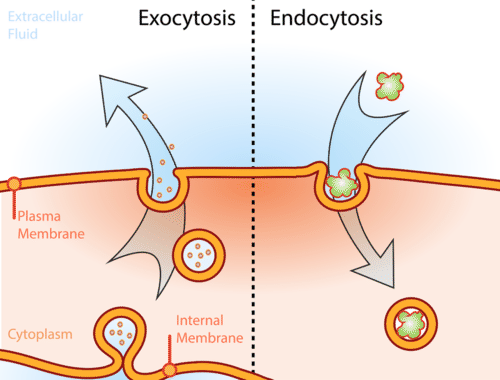4.32 异化和内分泌 - 高级
Section outline
-
What does a cell "eat"?
::什么是细胞"食"?Is it possible for objects larger than a small molecule to be engulfed by a ? Of course it is. This image depicts a cell being attacked by a cell of the immune system . Cells of the immune system consistently destroy by essentially "eating" them. Just as cells can bring substances into the cell, they can also export substances out of the cell.
::大于小分子的物体有可能被一个分子吞没吗? 当然它有可能。 这个图像描述了一个细胞受到免疫系统细胞攻击的情况。 免疫系统的细胞以基本上“ 食用” 的方式不断被摧毁。 正如细胞可以将物质带入细胞一样,它们也可以将物质输出出细胞。Vesicles and Active Transport
::车辆和主动运输Some molecules or particles are just too large to pass through the plasma membrane or to move through a transport protein . So cells use two other methods to move these macromolecules (large molecules) into or out of the cell. Vesicles or other bodies in the cytoplasm move macromolecules or large particles across the plasma membrane. There are two types of vesicle transport , endocytosis and exocytosis . These processes are active transport mechanisms, therefore energy is required.
::有些分子或粒子太大,无法通过等离子膜或通过迁移蛋白质。 因此, 细胞用另外两种方法将这些大型分子( 大型分子) 移入或移出细胞。 囊体或其他细胞体会移动大型分子或大颗粒, 穿过等离子膜。 有两种类型的输卵器迁移、 内分泌和异位体。 这些过程是活性迁移机制, 因此需要能量 。Endocytosis and Exocytosis
::内分泌中毒和外分泌Endocytosis is the process of capturing a substance or particle from outside the cell by engulfing it with the . The membrane folds over the substance and it becomes completely enclosed by the membrane. At this point a membrane-bound sac, or vesicle pinches off and moves the substance into the cytosol . There are two main kinds of endocytosis:
::内分泌固化是通过将物质或粒子与细胞一起吞没从细胞外捕捉物质或粒子的过程。 膜折叠在物质上, 并完全被膜封住。 此时此刻, 受膜约束的囊状膜, 或输卵管将物质切开并移入细胞索中。 有两大类内分泌中毒:-
Phagocytosis
or "cellular eating," occurs when the dissolved materials enter the cell. The plasma membrane engulfs the solid material, forming a phagocytic vesicle.
::当溶解物质进入细胞时,即发生细胞细胞化或“细胞进食”。等离子膜吞没固体物质,形成一个腺囊。 -
Pinocytosis
or "cellular drinking," occurs when the plasma membrane folds inward to form a channel allowing dissolved substances to enter the cell, as shown in
Figure
. When the channel is closed, the liquid is encircled within a pinocytic vesicle.
::如图所示,当等离子膜向内折叠以形成一个允许溶解物质进入细胞的通道时,就会发生皮质细胞中毒或“细胞饮用”的情况。当通道关闭时,液体就会被环绕在皮质囊内。
Transmission electron microscope image of brain tissue that shows pinocytotic vesicles. Pinocytosis is a type of endocytosis. Exocytosis describes the process of vesicles fusing with the plasma membrane and releasing their contents to the outside of the cell, as shown in Figure . Exocytosis occurs when a cell produces substances for export, such as a , or when the cell is getting rid of a waste product or a toxin. Newly made and membrane are moved to the plasma membrane by exocytosis.
::如图所示,蛋白质溶解说明了与等离子膜交融并释放其内装物到细胞外部的卵囊过程。当细胞生产物质出口时,如(......),或当细胞正在清除废物产品或毒素时,会发生蛋白质溶解,新制造的和膜会通过异子溶解转移到等离子膜。Illustration of the two types of vesicle transport, exocytosis and endocytosis. Endocytosis and exocytosis are types of vesicle transport that carry very large molecules across the cell membrane. Illustration of an axon releasing dopamine by exocytosis. Receptor-Mediated Endocytosis
::内分泌病Some substances are internalized after binding to a membrane-bound receptor. This process is known as receptor-mediated endocytosis (RME). RME is a process by which cells internalize molecules by endocytosis. This occurs by the inward budding of plasma membrane vesicles containing proteins with receptor sites specific to the molecules being internalized. After the binding of a ligand to the plasma membrane-spanning receptors, a signal is sent through the membrane, leading to membrane coating by the protein clathrin , and formation of a membrane invagination. The receptor and its ligand are then internalized in clathrin-coated vesicles. RME is also known as clathrin-dependent endocytosis, named after the clathrin protein that accumulates on the internal segment of membrane that will form a vesicle.
::某些物质在与受膜约束的受体结合后内化。 这个过程被称为受体中间内分泌( RME) 。 RME 是细胞通过内分泌内分泌分子的过程, 由血浆内分泌液中分泌蛋白的内化过程, 由血浆内分泌液中含有受体点的蛋白质。 在离子和血浆内分泌受体受体结合后, 信号通过薄膜发出, 导致由蛋白晶素涂膜, 形成膜内渗透。 受体内分泌的乳房内分泌液中, 受体内分泌细胞内分泌细胞内分泌素。 REME也被称为以聚积在会形成一种微粒的膜内分泌素内分泌。Homeostasis and Cell Function
::homeostasis 和单元格函数refers to the balance , or equilibrium within the cell or a body. It is an organism's ability to keep a constant internal environment. Keeping a stable internal environment requires constant adjustments as conditions change inside and outside the cell. The adjusting of systems within a cell is called homeostatic regulation. Because the internal and external environments of a cell are constantly changing, adjustments must be made continuously to stay at or near the set point (the normal level or range). Homeostasis is a dynamic equilibrium rather than an unchanging state. The cellular processes discussed in this lesson all play an important role in homeostatic regulation. More concerning homeostasis will be presented in additional concepts.
::细胞或身体内部的平衡或平衡是指细胞或身体内的平衡或平衡。它是有机体保持一个稳定的内部环境的能力。 保持稳定的内部环境需要随着细胞内外条件的变化而不断调整。 细胞内部系统的调整称为顺势调节。 由于细胞的内部和外部环境不断变化,必须不断调整,以保持在设定点(正常水平或范围)或接近设定点(正常水平或范围)的状态。 顺势保持是一种动态平衡,而不是一个不变状态。 本课中讨论的细胞过程在自制调节中都起着重要作用。 更多关于顺势调节的内容将在其他概念中提出。Summary
::摘要-
Endocytosis and exocytosis are active transport mechanisms in which large molecules enter and leave the cell inside vesicles.
::内分泌硬化和排出硬化是活性运输机制,其中大分子进入和离开囊内细胞。 -
In endocytosis, a substance or particle from outside the cell is engulfed by the cell membrane. The membrane folds over the substance and it becomes completely enclosed by the membrane.
::在内分泌中毒中,细胞膜将细胞外的物质或粒子吞没在细胞外,细胞膜折叠在物质上,完全被膜封闭。 -
There are two main kinds of endocytosis: pinocytosis and phagocytosis.
::内分泌硬化有两种主要类型:皮诺细胞中毒和脑膜硬化。
Review
::回顾-
What is the difference between endocytosis and exocytosis?
::内分泌硬化和排出硬化之间有什么区别? -
Why is pinocytosis a form of endocytosis?
::为什么皮诺细胞中毒是内分泌症的一种形式? -
Are vesicles involved in passive transport?
::车辆是否与被动运输有关?
-
Phagocytosis
or "cellular eating," occurs when the dissolved materials enter the cell. The plasma membrane engulfs the solid material, forming a phagocytic vesicle.



